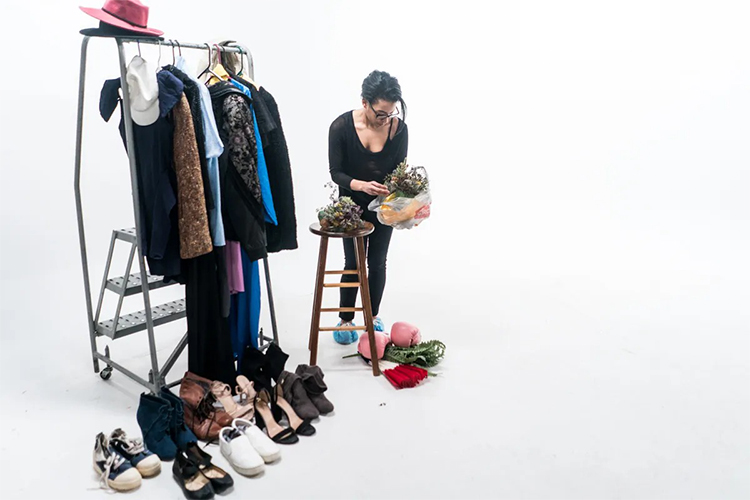The fashion industry is a constantly evolving and dynamic field that captures the attention of people all around the world. While the glitz and glamour of fashion shows and red carpet events often dominate headlines, there is a lot that goes on behind the scenes in a fashion studio that most people are not aware of. In this article, we will delve deeper into the intricate details of what happens in a fashion studio and the individuals who make it all happen.

The Creative Process
The creative process of designing a fashion collection is both exhilarating and challenging. It involves a multitude of steps that require a great deal of skill, creativity, and hard work. The process typically begins with a concept or theme, which is then translated into sketches by the designer. The sketches are then refined and turned into more detailed drawings that can be used to create a sample garment.
The next step involves working with a team of pattern makers, seamstresses, and other technicians to create the sample garment. This process can take several iterations and involves numerous fittings and adjustments to ensure that the garment meets the designer’s vision for the collection. Once the sample garment has been approved, the production process begins.
Production Process
The production process involves several different steps, each of which is essential to creating a high-quality garment. The first step is creating a production pattern that will be used to create the final garment. The pattern is typically created using computer-aided design (CAD) software, which allows for precise measurements and accurate pattern making.
Once the pattern has been created, it is graded to create different sizes of the garment to fit a range of body types. The pattern is then sent to the cutting room where it is cut from the chosen fabric. The cutting process is a delicate and precise task that requires skilled workers to ensure that the fabric is cut accurately and without waste.
The cut pieces are then passed on to the sewing room where the garment is sewn together by skilled seamstresses. The sewing process is a highly specialized task that involves intricate stitching and attention to detail to ensure that the garment is of the highest quality. Once the garment has been sewn together, it is fitted and adjusted to ensure that it fits the model perfectly.
Finishing Touches
The final stage of the production process involves adding any final details to the garment, such as buttons, zippers, and trimmings. This process is known as finishing and is an essential part of creating a high-quality garment. Once the finishing touches have been added, the garment is sent to be pressed and packaged for shipping.

Behind the Scenes Roles
Behind the scenes in a fashion studio, there are many different roles and responsibilities that are essential to the production process. The designer is responsible for overseeing the entire process and ensuring that the final garment meets their creative vision. They work closely with the pattern makers, seamstresses, and technicians to ensure that the garment is of the highest quality.
The pattern makers are responsible for creating the pattern for the garment and grading it to different sizes. They work closely with the designer to ensure that the pattern accurately reflects their vision for the collection. The seamstresses are responsible for sewing the garment together and ensuring that it fits perfectly. They use their skills and experience to create high-quality garments that are both comfortable and stylish.
In addition to these roles, there are also many other individuals working behind the scenes in a fashion studio. There are technicians who work on the machinery and equipment, ensuring that everything runs smoothly and efficiently. There are production managers who oversee the entire production process, ensuring that each step is completed on time and to the desired quality standards. There are quality control inspectors who ensure that each garment meets the desired standards of quality and that there are no defects or issues with the finished product.
Marketing and Branding
Marketing and branding play a crucial role in the success of a fashion studio. A strong brand identity can help to differentiate a studio’s designs from others in the market, and effective marketing can help to generate interest and build a loyal customer base. This involves creating a strong visual identity, developing marketing campaigns, and using social media and other platforms to reach potential customers.
Sales
Once a collection has been produced, the next step is to sell it. Fashion studios typically sell their collections through various channels, including e-commerce websites, brick-and-mortar stores, and wholesale to retailers. Sales teams work to establish relationships with retailers and buyers, negotiate deals, and manage inventory levels to ensure that products are available when customers want to buy them.

Distribution
Distribution is another important aspect of the fashion industry. It involves getting products from the production facility to the end consumer. This can involve working with logistics companies to ensure that products are shipped efficiently and cost-effectively. Many fashion studios also work with third-party logistics providers to manage their warehousing and shipping needs.
Sustainability
In recent years, there has been a growing focus on sustainability within the fashion industry. Many fashion studios are now implementing eco-friendly and sustainable practices into their production process. This includes using sustainable materials, reducing waste, and minimizing the environmental impact of the production process.
Sustainable fashion studios also focus on ethical practices, ensuring that workers are paid fairly and work in safe conditions. This is becoming increasingly important to consumers, who are now more aware of the impact that fast fashion can have on the environment and the people who produce it.
Conclusion
In conclusion, there is a lot that goes on behind the scenes in a fashion studio. The creative process of designing a collection is just the beginning, and the production process involves many different steps and individuals working together to create a high-quality garment. From pattern makers and seamstresses to technicians and quality control inspectors, each person plays a vital role in the production process.
With the growing focus on sustainability within the fashion industry, many studios are now implementing eco-friendly and ethical practices into their production process. This not only helps to reduce the environmental impact of the industry but also ensures that workers are treated fairly and work in safe conditions.
Next time you admire a stunning piece of clothing, remember that it took a team of skilled individuals and a lot of hard work to create it. The fashion industry is a complex and dynamic field, and the work that goes on behind the scenes is just as important as the finished product that we see on the runway or in the store.







